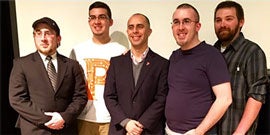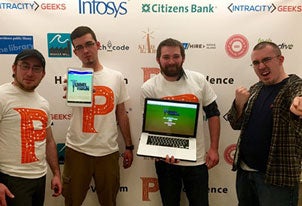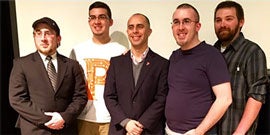 KINGSTON, R.I., April 28, 2016—Nicholas Peltier went to a hackathon at the University of Rhode Island last year and immediately felt regret: “It was so cool, I wished I had signed up.”
KINGSTON, R.I., April 28, 2016—Nicholas Peltier went to a hackathon at the University of Rhode Island last year and immediately felt regret: “It was so cool, I wished I had signed up.”
A few weeks ago, he found out about a hackathon in Providence and jumped at the opportunity. Good thing he did. Not only did the URI computer science major win first place, he came away believing that his product has a future in the tech world.
“It was very exciting,” says Peltier, 23, of Coventry. “It was surreal. As a computer science student I can use the win as part of my resume. It’s very validating to me personally.”
Peltier teamed up with four other computer whizzes from Massachusetts—Charles Randell, Richard Childers and Daniel Christensen and his brother, Joseph Christensen—to create Tunnel Vision, a Google Maps-oriented application that detects underground sewer and gas lines.
HackPVD, organized by Arnell Milhouse and Providence Mayor Jorge Elorza’s administration, was a free event April 15 through 17 at the Providence Public Library that challenged computer programmers to come up with creative solutions to solve city problems.
Peltier showed up at the event, without anyone to work with on a team. He went over to a group of guys who seemed to be around his age. They said they had an idea—the Tunnel Vision—and that they needed a programmer.
Peltier made his pitch: He suggested putting the application in a mobile phone with Smartwatch capabilities. He also told them he had experience programming Android phone applications, as well as Android Wear Smartwatch applications.
They clicked, and got to work.
Tunnel Vision could benefit companies who need to dig a hole in the ground before construction can start, even work as simple as a driveway foundation. To get permission to dig now, the companies have to go through Dig Safe.
Dig Safe contacts the various companies responsible for sewage, telecommunications and gas to determine if it’s safe to dig in a certain area. The process can take well over a month, which wastes time, money and resources.
Peltier and his team came up with the idea to use Google Maps. Here’s how it works: The user enters two street addresses and Google Maps displays the coordinates of that location, as well as the coordinates of the user’s location.
A three-dimensional cube appears in the phone app. A street view of Google Maps then shows up on top of the cube. By working with the user’s information and a database with the pipes’ location, size, depth and length, the code displays what’s in the ground.
The application also works with Smartwatches, guiding the user to a safe location to dig. In addition, the application has a step-counter feature. Every five steps the user takes, the cube is reloaded and redrawn, giving a seamless update at all times of what lies beneath.
Growing up in Coventry, Peltier never excelled in school. “I had a hard time fitting in,” he says. After graduating from high school, he enrolled at the Community College of Rhode Island, where he buckled down, making the Dean’s List.
In the spring of 2014, he earned his associate’s degree in liberal arts and transferred to URI the following fall. He enjoyed his programming classes at CCRI and decided to pursue more of those courses at URI.
“I flourished,” he says. “The professors are the biggest part of my success. They’re so smart and good at what they do. I also made excellent use of the tutoring centers and computer labs.”
Kunal Mankodiya, an assistant professor in the University’s Department of Electrical, Computer and Biomedical Engineering, provided guidance and instilled confidence in the URI senior.
“I don’t think I would have been able to do the hackathon without the knowledge I gained from Kunal,” says Peltier. “He taught me how to integrate Smartwatch data into mobile applications and that was really exciting.”
Mankodiya was happy to help: “After Nick watched the URI hackathon that I organized last fall he showed an immediate interest in joining our Wearable Biosensing Lab. In a few months, he rapidly demonstrated his ability to program modern Smartwatches and Smartphones. I’m really thrilled to see him win HackPVD. I suggested he play up his strength in programming. He executed the plan exactly. I’m so proud of him.”
Peltier is confident that Tunnel Vision has a future. He says the product is “incredibly” useful to cities and towns and could save them time and money. “It just goes to show,” he says, “that a simple idea and a dedicated team can produce something amazing.”
Pictured above:
From left to right: Daniel Christensen; Nicholas Peltier; Charles Randell; and Joseph Christensen. Photo courtesy of Nicholas Peltier.
From left to right: Daniel Christensen; Nicholas Peltier; Providence Mayor Jorge Elorza; Joseph Christensen; and Charles Randell. Photo courtesy of Intracity Geeks.

